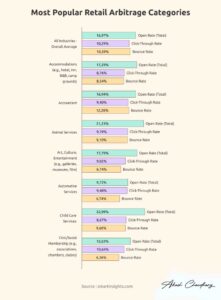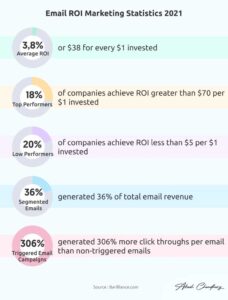You should never go to the battlefield before having won the war on paper
– Philip Kotler
You heard people saying grow your business with Email Marketing, Automation tools & Auto Follow-Ups.
But what exactly do you mean by Email Marketing?
Is it the one in which you regularly send and receive emails via Gmail, Yahoo & Hotmail?
The answer is NO.
It is something different.
Let’s take a scenario where you want to send an email to 10,000 people regarding an update of your newly launched product (which may be anything from an Ebook to a physically shipped product).
Would you send an email from Gmail to 10,000 people?
You might say No…
Yes, indeed you will go crazy!
Let’s take another scenario where you have an inquiry form on your website where a visitor will fill out a form to download a free brochure or software video tutorial.
After the visitor fills out the respective form and gets the video/brochure for free, normally you want to send a Welcome E-mail immediately.
Would you be monitoring 24*7 for your inquiry forms so that you can send an email manually to all those people when they fill-up the form for the video?
Logically that is impossible as they would never get an instant welcome email.
So the question still remains unanswered?
What is Email Marketing?
Let’s see what people are saying about this:
According to the Internet, Email marketing is a direct marketing channel that lets businesses share new products, sales, and updates with customers on their contact list. Its high ROI makes it crucial to most businesses’ overall inbound strategy.
It usually involves using email to send promotional offers, trust, or brand awareness campaigns. That helps businesses to generate viewership from the customers and send emails on Cold lists either the Current Customer database.
Broadly, the term is usually used to refer to sending email messages with the purpose of enhancing the relationship of a merchant with its current or previous customers, encouraging customer loyalty and repeat business, acquiring new customers, or convincing current customers to purchase something immediately, and adding advertisements to email messages sent by other companies to their customers.
In one of Mailchimp’s articles, Email marketing is a powerful marketing channel, a form of direct marketing as well as digital marketing, that uses email to promote your business’s products or services. It can help make your customers aware of your latest items or offers by integrating them into your marketing automation efforts.
In its broadest sense, every email sent to a potential or current customer could be considered email marketing.
Let’s make it as simple as bread & butter. In plain and simple terms, email marketing is all about promoting your brand or service via an email where the receiver has given you permission to send them an email.
This email can be categorized into different types as mentioned below:
Transactional Emails or Autoresponders:
Transactional emails are usually triggered based on a customer’s action which includes dropped basket messages, password reset emails, purchase or order confirmation emails, order status emails, reorder emails and email receipts, OTP-based emails, and banking transaction emails. The primary purpose of a transactional email is to acknowledge an action of a visitor on the website that has triggered it. Because of this, transactional emails are an opportunity to engage customers & build email relationships & trust with customers or subscribers.
Direct Emails or Broadcasts or Newsletters:
This is an email where a business is trying to communicate promotional content via its email. Eg: An update regarding some product launch.
This can be done by 2 methods which we can categorize as Permission based E-mails or Spamming.
These 2 things always keep in mind when you plan any E-mail campaigns. Which strategy do you have to Opt-In. First readout both scenarios & tell me which one is beneficial for your business.
Which Email strategy is better to Opt-In (Single vs. Double)
Let’s understand with the examples
1st Case
Let’s say Ivaan builds a webpage with the name of Digital Wallah & URL will be like this https://www.digitalwallah.online.
He is offering Digital Marketing Services as well as selling courses online. Does he want to offer a FREE E-book on How to Make Money Online? In exchange for the visitor’s first name & email.
Once any visitor fills in the information and clicks on the Download button, the visitor would be redirected to another web page where he would be able to get the downloadable eBook.
Along with this redirection, the visitor would also receive one Automated email which would be acting like a Thank you email (Autoresponder) for the visitor taking an action on Ivaan web page.
If we talk about the activity done by the visitor to get the ebook, then we can say that he/she only did ONE SINGLE activity which is filling out the form.
2nd Case
Ivaan builds another web page & now he is offering a FREE SEO Course on email marketing in exchange for a visitor’s first names & emails. Once any visitor fills in the information and clicks on the “Access the course” button, the visitor would be redirected to another web page where he would have a message quite similar to the one mentioned below:
“Thank you for entering your information. We have sent you an email to confirm your details and subscription. Please check your email with the subject line – “Learn Step by Step SEO strategies to increase the traffic by 200% with Akash Chaudhary”
Along with this redirection on the confirmation message web page, the visitor would also receive one Automated email which would be asking the visitor to click on the link inside the email to confirm access to the SEO Course. Once the visitor clicks on the link in the email, he/she would be redirected to Ivaan web page where the visitor will now finally have access to the offer (free SEO Course) and the visitor would also receive an acknowledgment email (autoresponder) having the SEO course link as well. So, later on, he/she can access the course & send reminders to finish the course as well. If we talk about the activity done by the visitor to get access to the SEO course, then we can say that he/she did TWO activities we called (Double opt-in).
Double Opt-In Advantages:
This double Opt-In method helps in eliminating the chance of spam where somebody submits someone else’s email address without their knowledge or consent. It helps control wrongly typed addresses or mistyped email addresses not being added to the list automatically, and the user has a chance to sign up again with the correct email address and subscribe again – this time, it is to be hoped, with the correct address.
Since only people who have the intention to remain on a list end up on it, messages are more targeted. This will definitely increase the conversation rates with lower un-subscription rates.
Double opt-in also guards against accusations of spamming.
This is very important for any business who is running online.
All the top email service providers which are out there, work very hard to make sure that your emails are not blocked by major ISP’s. But they can’t guarantee that your emails would land in the inbox or spam.
They will calculate a spam score before you send your emails; however, getting whitelisted is the most effective way to ensure that your emails get delivered properly.
Alright! Please tell me what is getting Whitelisted all about? I know this was the same reaction when I heard it for the first time.
Essentially, getting whitelisted is equivalent to being marked as a friend, and the best way to achieve this is by being added to the recipient’s address book.
The best way to do this is by providing instructions to do so at the top of each email, especially on the initial thank you and first follow-up email.
9 Email Marketing Terms you Need to Know
It can be confusing right?
We’re going In-depth one by one and simply show you here what all this stuff means and it helps you if you get stuck or forget something.
Here you go one by one:-
1.) A/B Split Test: This simply refers to “testing” two different email creatives to your list. You’re splitting it 50/50 to see which one gets the better response rate and statistics.
2.) Auto-Responder: This is an email that “automatically” goes out to someone on your list. It’s typically activated by someone “subscribing” to the list, although there are other options to activate an auto-response message. Typically mailers have a complete “sequence” of emails that are sent to their subscribers over a certain period of time.
3.) Bounced Email: This is an email that is not delivered. There are 2 types of bounces soft and hard. Soft bounces are emails that are not delivered to real email addresses and are less problematic. Hard bounces are typically spam traps or invalid email addresses. Having a large % of hard bounces is very bad and can result in your sending account being shut down.
4.) Call To Action: Also known as CTA is simply the part of an email that tells the user to “take action” and click on the link provided in the email creative.
5.) CTR: This is your CLICK THROUGH RATIO it’s just the amount of times someone clicks on your links in your email vs the amount you have sent out. We often times check our CTR in two different ways: The % of people who clicked based on the “Open Rate” and The % of people who clicked based on the total amount of mail sent.
6.) Double opt-in: A process that requires new list joiners to take an action (such as clicking on an emailed link to a personal confirmation page) in order to confirm that they do want to be on the list. If double opt-in is turned on when you acquire subscribers you are unable to send emails to anyone who doesn’t click on the confirmation link sent to them.
7.) Open Rate: This is just the number of people who opened an email you’ve sent divided by the number of total emails sent out. This is one of the key factors we look at when determining if our mailing strategy is working.
8.) Personalization: An optimization method in which an email message looks to have been created only for a single recipient. Personalization techniques include adding the recipient’s name in the subject line or email message. You can also include the recipient’s email address, location, or any other valid information to make the email “personalized”.
9.) Unsubscribe: To remove yourself from an email list. Typically all emails have an “unsubscribe” link located at the bottom of them.

Conclusions
Email Marketing is the best way to generate an authentic Subscribers base to increase ROI or revenue if you Opt-in right strategy.
You should never go to the battlefield before having won the war on paper. So, before planning any campaign you’ve to choose precisely which type of email campaign is better for you (Traditional vs Promotional e-mails)
We are always confused about which strategy is better for us to choose from Single vs Double Opt-In. According to me, you’ve to choose the Double Opt-In strategy that will help you to collect the right email subscribers to the list. These are not only your subscribers they’re your Audience/Fans that will become LTV(Lifetime Value) customers in the future. If you’ll add value to their life or career.

